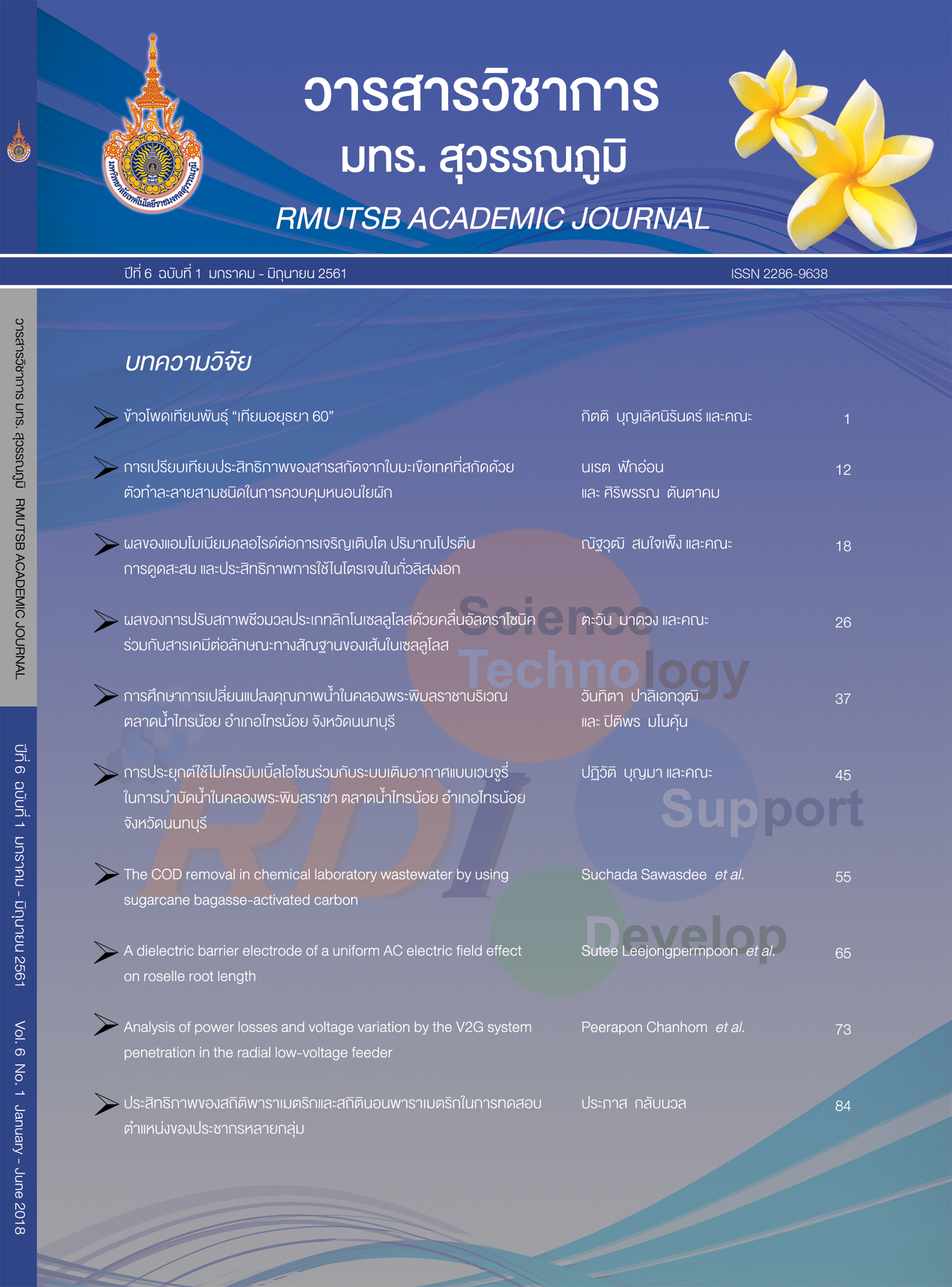The COD removal in chemical laboratory wastewater by using sugarcane bagasse-activated carbon
Main Article Content
Abstract
Chemical oxygen demand (COD) has been the crucially problematic parameter in chemical laboratory wastewater. This study was conducted to investigate the COD adsorption onto activated carbon prepared from sugarcane bagasse in batch process. The effects of adsorption such as contact time (5-240 min) and adsorbent dose (0.5-5.0 g) were evaluated. The adsorption reached the equilibrium at 120 min and the percentage of adsorption increased with increasing adsorbent dose. The equilibrium adsorption data were analyzed using Langmuir and Freundlich adsorption isothermat 30 ºC. It was found that the adsorption correlated well with the Langmuir model and the maximum monolayer adsorption capacity was 29.15 mg/g. The kinetic data followed pseudo-second order model. The study revealed that the activated carbon prepared from sugarcane bagasse can be used as an adsorbent for the removal of COD in chemical laboratory wastewater.
Article Details
Published manuscript are the rights of their original owners and RMUTSB Academic Journal. The manuscript content belongs to the authors' idea, it is not the opinion of the journal's committee and not the responsibility of Rajamangala University of Technology Suvarnabhumi
References
Abdel-Ghani, N.T., E.S.A. Rawash and G.A. El-Chaghaby. 2016. Equilibrium and kinetic study for the adsorption of p-nitrophenol from wastewater using olive cake based activated carbon. Global J. Environ. Sci. Manage. 2(1): 11-18.
Ahmed, S.M., F.I. El-Dib, N.S.E. Gendy, W.M. Sayed and M. El-Khodary. 2016. A kinetic study for the removal of anionic sulphonated dye from aqueous solution using nano-polyaniline and Baker's yeast. Arabian Journal of Chemistry 9(2): S1722-S1728.
Ahmad, R. and R. Kumar. 2010. Adsorption studies of hazardous malachite green onto treated ginger waste. Journal of Environmental Management 91(4):1032-1038.
Ahmad, A.A and B.H. Hameed. 2009. Reduction of COD and color of dyeing effluent from a cotton textile mill by adsorption onto bamboo-based activated carbon. Journal of Hazardous Materials 172 (2-3): 1538-1543.
Ali, I. 2012. New generation adsorbents for water treatment. Chem. Rev. 112(10): 5073-5091.
Almeida, C.A.P, N.A. Debacher, A.I. Downs, L. Cottet and C.A.D. Mello. 2009. Removal of methylene blue from colored effluents by adsorption on monmorillonite clay. Journal of Colloid and Interface Science. 332(1): 46-53.
Azmi, N. B., M.J.K. Bashir, S. Sethupathi, L.J. Wei and N.C. Aun. 2015. Stabilized landfill leachate treatment by sugarcane bagasse derived activated carbon for removal of color, COD and NH3-N - Optimization of preparation conditions by RSM. Journal of Environmental Chemical Engineering 3(2): 1287-1294.
Benatti, C.T., C.R.G. Tavares, B.P.D. Filho and M.P. Gaspar. 2003. Sequencing batch reactor for treatment of chemical laboratory wastewater. Acta Scientiarum Technology 25(2): 141-145.
Bennani, K.A., B. Mounir, M. Hachkar, M. Bakasse and A. Yaacoubi. 2015. Adsorption of cationic dyes onto Moroccan clay: Application for industrial wastewater treatment. J. Mater. Environ. Sci. 6(9): 2483-2500.
El-Naas, M.H., S. Al-Zuhair and M. Abu Alhaija. 2010. Removal of phenol from petroleum refinery wastewater through adsorption on date-pit activated carbon. Chemical Engineering Journal 162(3): 997-1005.
Fytianos, K., E. Voudrias and E. Kokkalis. 2000. Sorption-desorption behaviour of 2,4-dichlorophenol by marine sediments. Chemosphere 40(1):3-6.
Halim, A.A., H.A. Aziz, M.A.M. Johari and K.S. Ariffin. 2010. Comparison study of ammonia and COD adsorption on zeolite, activated carbon and composite materials in landfill leachate treatment. Desalination 262(1-3): 31-35.
Ibrahim, S.C., M.A.K.M. Hanafiah and M.Z.A. Yahya. 2006. Removal of cadmium from aqueous solutions by adsorption on sugarcane bagasse. Am-Euras J. Agric Environ. Sci. 1(3): 179-184.
Low. L.W., T.T. Teng, A.F.M. Alkarkhi, A. Ahmad and N. Morad. 2011. Optimization of the adsorption conditions for the decolorization and COD reduction of methylene blue aqueous solution using low-cost adsorbent. Water Air Soil Pollut. 214(1): 185-195.
Martin, M.J., A. Artola, M.D. Balaguer and M. Rigola. 2003. Activated carbons developed from surplus sewage sludge for the removal of dyes from dilute aqueous solutions. Chemical Engineering Journal 94(3): 231-239.
National research council (U.S.). 1995. Prudent practices in the laboratory: Handling and disposal of chemicals. National academy press, Washington.
Nethaji, S., A. Sivasamy and A.B. Mandal. 2013. Adsorption isotherms, kinetics and mechanism for the adsorption of cationic and anionic dyes onto carbonaceous particles prepared from Juglansregia shell biomass. Int. J. Environ. Sci. Technol. 10(2): 231-242.
Omri, A., A. Wali and M. Benzina. 2012. Adsorption of bentazon on activated carbon prepared from Lawsoniainerm is wood: Equilibrium, kinetic and thermodynamic studies. Arabian Journal of Chemistry 9(2): S1729-S1739.
Palanisamy, P.N., A. Agalya and P. Sivakumar. 2013. Polypyrrole composite - A potential Material for the removal of acid dyes. Asian Journal of Chemistry 25(11): 5891-5896.
Zhu, Y and P. Kolar. 2016. Investigation of adsorption of p-cresol on coconut shell-derived activated carbon. Journal of the Taiwan Institute of Chemical Engineers 68: 138-146.
Zhang, L., H. A. Loáiciga, M. Xu, C. Du and Y. Du. 2015. Kinetics and mechanisms of phosphorus adsorption in soils from diverse ecological zones in the source area of a drinking-water reservoir. Int. J. Environ. Res. Public Health. 12(11): 14312-14326.


